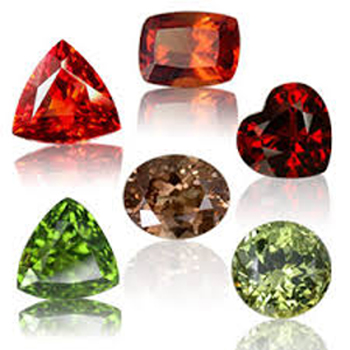
Garnet can be applied in various applications and industries. An abrasive garnet can be broadly divided in two categories--blasting grade and water jet grade. It is particularly popular due to its consistent supplies, huge quantities and clean material.

Gemstones
Red garnets were the most commonly used gemstones in the Late Antique Roman world, and the Migration Period art of the "barbarian" peoples who took over the territory of the Western Roman Empire. They were especially used inlaid in gold cells in the cloisonné technique, a style often just called garnet cloisonné, found from Anglo-Saxon England, as at Sutton Hoo, to the Black Sea.
Pure crystals of garnet are still used as gemstones. The gemstone varieties occur in shades of green, red, yellow, and orange. In the USA it is known as the birthstone for January. It is the state mineral of Connecticut, New York's gemstone, and star garnet (garnet with rutile asterisms) is the state gemstone of Idaho.
Industrial Uses
Garnet sand is a good abrasive, and a common replacement for silica sand in sand blasting. Alluvial garnet grains which are rounder are more suitable for such blasting treatments. Mixed with very high pressure water, garnet is used to cut steel and other materials in water jets. For water jet cutting, garnet extracted from hard rock is suitable since it is more angular in form, therefore more efficient in cutting. Garnet paper is favored by cabinetmakers for finishing bare wood. Garnet sand is also used for water filtration media.
As an abrasive garnet can be broadly divided in two categories--blasting grade and water jet grade. The garnet, as it is mined and collected, is crushed to finer grains; all pieces which are larger than 60 mesh (250 micrometers) are normally used as sand blasting media. The pieces between 60 mesh (250 micrometers) and 200 mesh (74 micrometers) are normally used for water jet cutting. The remaining garnet pieces that are finer than 200 mesh (74 micrometers) are used for glass polishing and lapping. Regardless of the application, the larger grain sizes are used for faster work and the smaller ones are used for finer finishes.
There are different kinds of abrasive garnets which can be divided based on their origin. The largest source of abrasive garnet today is garnet-rich beach sand which is quite abundant on Indian and Australian coasts and the main producers today are Australia and India.
This material is particularly popular due to its consistent supplies, huge quantities and clean material. The common problems with this material are the presence of ilmenite and chloride compounds. Since the material has been naturally crushed and ground on the beaches for past centuries, the material is normally available in fine sizes only. Most of the garnet at the Tuticorin beach in south India is 80 mesh, and ranges from 56 mesh to 100 mesh size.
Garnet has been mined in western Rajasthan in northwestern India for the past 200 years, but mainly for the gemstone grade stones. Abrasive garnet was mainly mined as a secondary product while mining for gem garnets and was used as lapping and polishing media for the glass industries. The host rock of the garnet here is garnetiferous mica schist and the total percentage of garnet is not more than 7% to 10%, which makes the material extremely costly and non-economical to extract for non-gemstone applications.